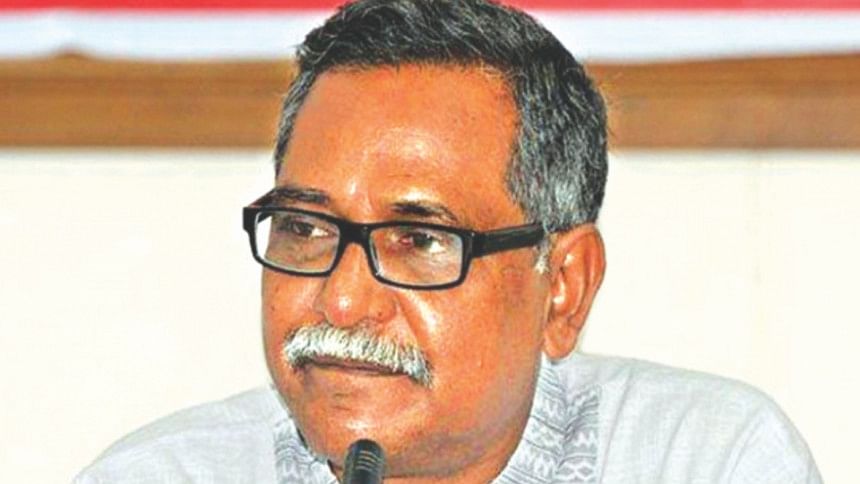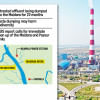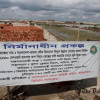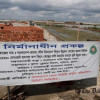Risk of losing Sundarbans

Sundarbans, a magnificent and unique ecosystem of the world, faces an existential question today with a coal power plant to be set up at Rampal. It has been a content of discord between environmentalists and those who are pushing the plant. Both sides are giving out their own arguments in favour of and against the plant to be set up within 14km of the mangrove forest. The Daily Star wants to bring to the public the arguments and the counterarguments that the protagonists and antagonists of the plant have to make. Today we publish an interview of Professor Anu Muhammad, Department of Economics, Jahangirnagar University, on the issues of Rampal power plant. Pinaki Roy and Shahtub Siddique Anik took the interview.
The Daily Star (TDS): Government officials say the Rampal power project won't cause any damage to the Sundarbans. But what is the reality? Why do you think this plant will have an adverse impact on the Sundarbans? How did you get involved in the movement against this project?
Prof Anu: It's not entirely true that government officials are saying there won't be any damages. Recently, the finance minister admitted that the Sundarbans will be affected. And I am sure there are others in the government who in private will agree on this, contradicting the official version.
The Sundarbans, the largest mangrove forest in the world, largely depends on water. It is alive because of its water bodies -- rivers, canals and tributaries. If water is contaminated at one point, the entire forest would suffer. We have reasons to be concerned. We have enough scientific evidence that the coal-fired plant in Rampal and many business projects inspired by this will kill the forest.
We first heard about the project back in 2010 from the locals in the Sundarbans areas. They were already protesting the government decision. When the land acquisition for the plant began that year, a land protection committee was formed. But they failed to stop the land acquisition. They contacted us.
We found anomalies as we went there. The land acquisition began without any site clearance or environmental assessment. Before acquiring land for a project, there are certain procedures to be followed -- serving notice, consultations, dialogues with people and so on. In this case, there was nothing of this sort. Instead, people were being coerced, terrorised and threatened with eviction. We even heard threat of “crossfire” was made.
The people there are mostly poor and a section of them are low-caste Hindus. Both groups are helpless. Low-caste Hindus suffer even more. So it was easy for powerful people to displace them.
After we learnt about the plant, we tried to find the details. Firstly, we tried to understand the environmental impacts of coal plants around the world, including India, China, US and Australia. They have decades of experience. That's why studies on these are available. Moreover, we went through scientific studies on the Sundarbans itself, its special features, importance, sensitivity as well as vulnerability. To what extent can a mangrove forest like the Sundarbans endure abuse? How sensitive is it? Gradually we became convinced that the Rampal plant will surely wreak havoc on the forest.
TDS: But in the case of the Rampal project, the prime minister claimed necessary measures will be taken; therefore, the coal-fired plant won't affect the Sundarbans. Officials also argue that it is a unique forest which cannot be harmed so easily. It is also being said that oil and fertiliser tankers have sunk there but did not have any lasting effect.
Prof Anu: Studies on the Sundarbans and coal-fired plants do not support these claims. All this rhetoric goes against simple commonsense.
If the government is capable of protecting the Sundarbans, then why is it failing to save the Buriganga and many other rivers from grabbing and pollution? It is a much easier and achievable job. If NTPC has the technology to do the impossible then why does it have such a bad record in India?
In fact, the government spokespersons aren't saying things based on their own understanding. They are just parroting the company's marketing propaganda. This is shameful. It has become clear the government is not at all serious about the Sundarbans; they appear pretty insensitive about saving the forest. For example, one adviser said that if necessary another Sundarbans will be created. It was before our 2013 long march.
Another argument that there was no disaster even after the sinking of tankers is also irresponsible. We haven't forgotten how the government responded to the sinking of a coal-laden ship in the Sundarbans. The UNDP and other studies showed that these will have long-term disastrous effect on the forest. And for the Rampal plant, hundreds more ships will transport coal through the Sundarbans. Just one accident -- and it will be the death of the Sundarbans.
TDS: But it is also said coal cannot contaminate water and it actually works as filter …
Prof Anu: Yes. I heard this unbelievable statement from the prime minister. It is a simple fact that there is a difference between coal (natural mineral) and charcoal (obtained by burning wood). We used to clean our teeth with charcoal when we were kids, but the one which is a natural mineral extracted from mines, contains toxic substance.
TDS: The prime minister said that high-quality coal will be brought from South Africa, Australia… it would be transported carefully… Coal will be well-covered… coal will not cause pollution...
Prof Anu: There is no evidence to back these claims. There is no instance in the world that coal is being transported on a ship and water is not being polluted at all.
For the Rampal plant, 12,000 tonnes of coal will be shipped through the forest every day -- about 500 ships and 47 lakh tonnes in 365 days. It is not a valid argument that there is no risk of accident or pollution.
Then there is another serious issue -- burning of coal, 47 lakh tonnes a year. And it will be 14km off the forest -- in fact 4km. Because the buffer zone of the Sundarbans is considered as Ecologically Critical Area (ECA). The plant is just 4km from the ECA.
So, 47 lakh tonnes of coal burned there will create more than nine lakh tonnes of ash, of which 80% will be dry fly ash and the rest 20% bottom ash. This ash will contain many heavy metals, including arsenic, lead, mercury, nickel, vanadium, beryllium, barium, cadmium, chromium, selenium, and radium, which are dangerous if released into the environment.
TDS: But it's super critical technology…
Prof Anu: The EIA (Environmental Impact Assessment) report says super critical technology will be used. What we learnt from countries like India or Australia is that such technology can reduce pollution only by five to ten percent. So 90 percent pollution will be there.
Now they are talking about ultra-super critical technology. There is a limit to attempts to fool people. What technology will be used is already determined in the EIA. It is linked with expenditures, investment, etc. The company which got the construction job and those who will provide loans will follow the deals already signed. They will not let the cost go up.
The government has been playing hide and seek from the very beginning. People are being fed wrong information. We still don't know exactly from where the coal will come. They say coal will be imported from Australia or Indonesia. But we have doubts for obvious reasons.
Exim Bank is providing loans for the plant against sovereign guarantee from the Bangladesh government. According to the bank's own policy framework, it lends only in projects which ensure export of Indian products. We have seen this happen with its previous loans to Bangladesh.
At the same time, media reports say Coal India has shown interest in supplying coal to the Rampal plant. They have a surplus of coal as some coal plants have been shutdown in India.
Analysing all these factors, we doubt that high-quality coal from Australia or Indonesia or South Africa will be used here.
TDS: How do you explain the contract? Don't you think it is a friendship contract between two countries?
Prof Anu: Our Power Development Board and India's NTPC have formed a friendship company. To us, this is no friendship company; it's something that will create permanent enmity between the two countries.
On paper, Bangladesh and India have 50-50 ownership. But NTPC is in the management. An Indian company is handling the construction work. The construction materials will be duty-free. Imported materials will be tax-free. Profit will be tax-free. Exim India will have a business by providing a loan, and very likely an Indian coal company will supply the coal.
This is not a win-win project; it's a win-lose project. Only Indian companies are the winners, for Bangladesh there will be only disaster, only irreparable loss, loss of the Sundarbans and also a huge financial burden on Bangladesh.
TDS: But Bangladesh will get electricity at a lower price, right?
Prof Anu: No, not at all. It will be costlier. Already we hear about Tk 8 to 9 per unit. According to analysis of International Energy Institute, it's more than Tk 9 if we consider hidden subsidies. In Bangladesh, electricity generated from gas costs about Tk 2. Power from rental/quick rental plants costs from Tk 12/13 to 16/17.
In the case of Rampal, coal electricity, which is supposed to be the cheapest, is going to cost about Tk 10. And the way project cost increases in Bangladesh and the way the whole process lacks transparency, the price would go up.
Besides, we don't yet know the price of the coal.
And if we follow standard cost-benefit analysis and include environmental and social cost into the calculation, electricity from coal becomes the costliest electricity.
TDS: But whatever the government is doing is not illegal after all.
Prof Anu: The problem with existing laws is that those are not updated enough. Still, the plant won't be acceptable if we consider laws about water bodies, water, forest or river properly.
In fact the government has a lot to learn from India. They have long-time experience of coal-fired power plants. Because they know the impact better, they formed national green tribunal to scrutinise coal power projects. They also have formulated environmental guidelines in 2010 to check major loss from setting up thermal power projects. Even projects by NTPC in a number of cases were halted by the tribunal.
TDS: The prime minister has claimed that the Barapukuria coal power plant is not causing any damage to the environment. Why do you think Rampal plant will affect the Sundarbans?
Prof Anu: Evidence from the ground contradicts this claim. We got many field studies pointing to many issues like water pollution and problems relating to underground and drinking water and cultivation. Moreover, it is practically producing maximum of 125 megawatt; the Rampal plant is 10 times bigger. Most importantly, the Rampal plant is close to the Sundarbans.
TDS: If the plant is moved from Rampal will you still oppose it? Do you have any other alternative suggestions?
Prof Anu: Proper site selection requires transparent steps, people's consent, independent EIA and environmental and site clearance. But the government chooses coercion, muddling facts, and manipulating the EIA. If they can follow the right conditions and select site elsewhere, we have no problem. But people will never accept projects of corruption and destruction.
We also suggest exploring alternatives to coal. Since Bangladesh is densely populated, its land and water resources are all-important. Therefore, the impact of the coal power project is extraordinary here.
If the government can set up a power plant by importing coal then what's wrong with importing gas? Its environmental and social costs are much lower. Secondly, we have huge potential of gas resources offshore, but the government is showing reluctance to develop national capability to explore and use gas for building big power plants. Thirdly, it is urgent to bring renewable energy to mainstream from the periphery. New technology is developing fast, cost is coming down and Bangladesh has high potential for that.
TDS: But countries like China, India and US are using coal plants. Don't we need development?
Prof Anu: Yes, we need development. And yes, these countries use coal as major source of power. But the present trend in those countries is that they are doing everything to phase out coal. We should not copy a hundred-year-old development model. When better technology, solar technology, etc were not available, they relied on coal. They were not fully aware of the impacts of coal. Now people across the globe are more aware and they are looking for alternatives.
We should not make ourselves a dumping ground of rejected technology; rather we should take advantage of newer ones.
Besides, we don't have the capacity the developed countries have built over the years to tackle disaster. We can't afford to spend billions of dollars if our water is polluted.
Another argument is that the level of our carbon emission is low -- so why worry? This is a stupid argument. You may compete over carbon emission. But how can you do it after attempting to destroy the Sundarbans?
The Sundarbans has a special role in the fight against climate change effects. The government is signing deals over climate change, bringing in funds but destroying the country's strongest shield in this battle -- the Sundarbans. We can't afford to lose the Sundarbans.
(Prof Anu Muhammad teaches economics at Jahangirnagar University. A political activist and writer, he is the member secretary of the National Committee to Protect Oil, Gas, Mineral Resources, Power and Ports. He is currently the frontman of the movement against the Rampal power plant being built close to the Sundarbans.)

 For all latest news, follow The Daily Star's Google News channel.
For all latest news, follow The Daily Star's Google News channel. 








Comments